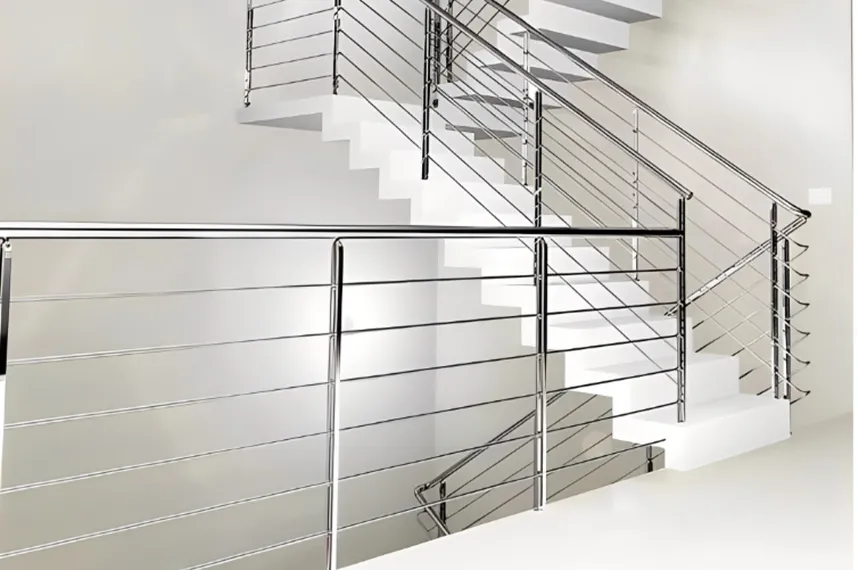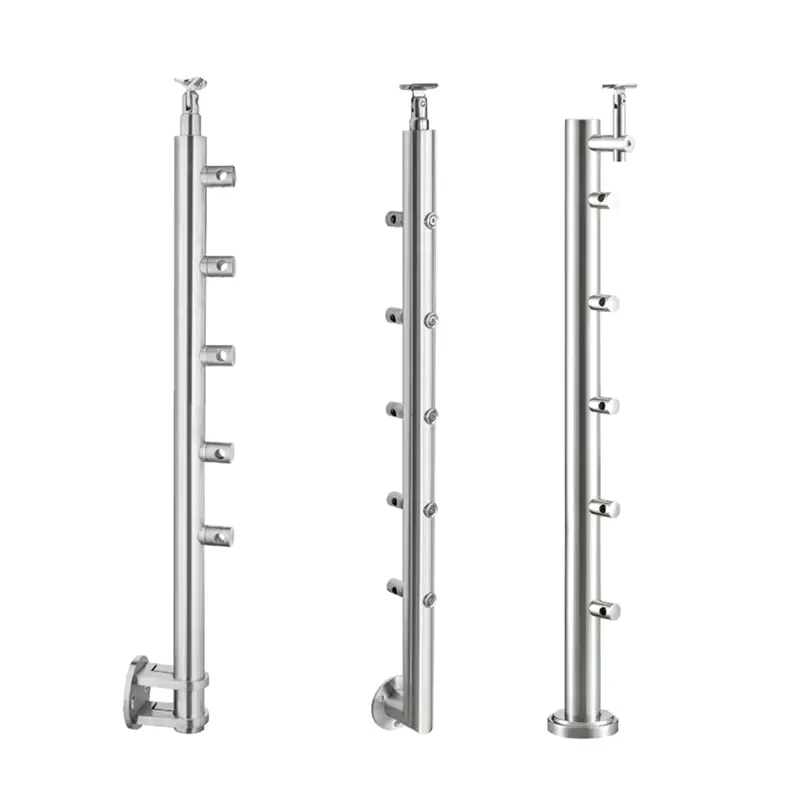Picking the right guard is tricky Agitate: Wrong choices rust, fail code, and spoil sightlines. Use a simple stainless steel handrail plan that marries safety, longevity, and clean style.
Stainless steel handrail design means selecting grade, layout, posts, and finishes so stairs, decks, and balconies meet code and look good. It balances structure, spacing, and surface to give strong, low-maintenance protection with clear guidance for ordering and installation.
A good design starts with fit-for-purpose stainless steel and clear code intent. You balance looks, strength, and maintenance. The handrail must be comfortable to grip, the railing must resist loads, and the layout must guide people along each stair and landing. Small choices—tube size, bracket type, and end caps—change comfort and safety.
Equally important is buildability. Choose standardized railing parts ve ready to install kits where possible. Pre-engineered posts with pre-drilled bases and fitting options speed work and cut errors. A consistent module makes custom work feel seamless, even on a modern staircase.

Merdiven Çelik Izgara Tasarımı
Most indoor metal railings use Type 304. It’s versatile and cost-effective for lobbies, offices, and retail. For coastal sites, pools, or de-icing salts, Type 316 adds molybdenum for superior corrosion resistance in chlorides; it offers excellent corrosion resistance vs 304 in many salty or chemical settings.
For harsher marine zones or splash decks, some teams step up to duplex “marine-grade” options for extra korozyon di̇renci̇ and strength. These withstand chlorides better than conventional austenitic grades in tough exposures.
Look for material certified to ASTM A240 when you specify sheet/plate for posts, caps, or stringers in stainless steel rail work; it standardizes chemistry and properties across stainless steel grades used in architectural components.
Cable railing shines on a deck, terrace, or balcony where you want unobstructed views and an airy feel. Tensioned cable in stainless steel posts blends safety with minimal sightlines. A paslanmaz çeli̇k kablo korkuluk gives clean lines and sleek appearance for a custom home or boardwalk.
A cam korkuluk maximizes visual appeal ve aesthetic appeal in upscale retail or hospitality. Use tempered glass panels with stainless steel posts when clarity matters most. It’s elegant, but plan for cleaning and wind loads.
Panel infill (perforated metal or rods) hits the sweet spot for schools, stadiums, or transit, providing airflow, patterning, and robust durability. Many owners pick panel infill for tamper resistance and long service in residential and commercial settings.

Code separates graspable stair handrail from perimeter guards. Typical handrail height is 34–38 inches measured from the nosing line; guards at edges (landings, decks) are commonly 42 inches minimum. Always confirm your local adoption of IBC/IRC.
On a wall railing beside a staircase, keep clearances for grasping, and remember that a guard top at 42 inches often requires a lower, graspable stair rail when used on stairs.
Finish affects both looks and maintenance. Brushed stainless steel ve satin finish hide fingerprints and minor scuffs in commercial or residential spaces. “Satin” hits a calm, modern tone. A mirror-like polish screams showpiece but needs more care.
Near coasts, avoid coarse brush textures and crevices that trap chlorides. Smoother finishes shed contaminants and improve corrosion performance—especially on balcony rails facing salt spray.
Designers also explore black stainless steel or powder-coated accents for contrast. Use high-quality stainless steel underneath; finish is only a skin if the base alloy can’t cope with the environment.
A modern railing system is a kit of parts:
Bu handrail is made from polished tube or formed shapes; many teams pick a satin or satin finish for low-glare elegance. For stairs, specify smooth joints and a continuous grip through turns—your handrail system should guide people without breaks.

Stainless Stair Railing posts
Good drawings plus precise site data win the day. Field-verify structure, slopes, and anchor zones. Choose posts with pre-drilled bases, match fasteners to substrates, and keep a standard module. Many suppliers offer ready to install kits where post heights, shoes, and corners already fit your plan.
Preassemble sections at floor level when possible. Protect stainless steel during railing installation: tape, blankets, and clean gloves. After tensioning cable, re-check deflection and gripper torque. The result is safe, straight, and clean.
Stainless steel costs more up front than mild steel paint, but total cost of ownership often favors stainless steel—fewer repaints, fewer part swaps, better resale. For a deck or terrace, that means fewer shutdowns and happier guests.
Lifecycle Snapshot (typical, illustrative)
| Option | Initial Cost | Maintenance | Expected Life | Notes |
| Painted carbon steel | $$ | High | 10–15 yrs | Repaint every 3–5 yrs |
| Stainless steel (304) | $$$ | Low | 20+ yrs | Interior or mild exterior |
| Stainless steel (316) | $$$$ | Low | 25+ yrs | Chlorides / coastal use |
Text-only “chart” (relative corrosion resistance)
Painted carbon steel | ███
Type 304 | ███████
Type 316 | ██████████
Duplex | █████████████
(Use 316 or duplex where salt or de-icing is present; duplex raises capacity in small sections).
Guards and handrail assemblies must resist concentrated and linear loads. Use manufacturer span tables and project-specific calc packages. Specify welds and fasteners for the same alloy family. For tough exposures, choose corrosion-resistant fasteners and sealants.
Why stainless steel? Its passive chromium layer gives durability ve korozyon di̇renci̇. Type 316’s molybdenum improves pitting/crevice behavior in chloride splash—think pool decks and ferry terminals. Duplex offers higher strength and chloride performance. For most indoor lobbies, Type 304 is the best stainless steel bet for cost and aesthetics.
When you specify, call out stainless steel railing systems with tested details. For seaside work, include routine freshwater rinse guidance in O&M. That small task keeps rails resistant to corrosion for the long haul.
Polished stainless steel handrails create sparkle in entries and atriums; they pair well with stone and wood. Satin finish is calmer, forgiving, and camera-friendly. Where branding demands accent color, designers use powder-coated shoes or top rails over a stainless steel frame.
Match finish to use: kitchens, clinics, and schools like low-glare, easy-clean surfaces. Museums and hotels lean shiny for drama. Balance sheen with fingerprints, lighting, and cleaning staff routines.
Use cable railing systems on a deck, pier, or rooftop lounge where breeze and view matter. Tensioned cable lines reduce infill maintenance and deliver strong railing performance with slim visual weight. For wind-prone zones, verify post stiffness and corner details.
On coastal façades, pick 316 posts and hardware, set drain paths in shoes, and avoid dirt traps. Good detailing plus periodic rinsing improves service life. For cold climates with salts, stainless steel still beats paint over time.
Seaview Hotel Balcony Balustrade. The architect wanted elegance and tough salt resistance. We proposed stainless steel posts in 316 with kablo korkuluk infill. The balustrade kept sightlines open for suites and the restaurant terrace, preserving views of the bay. Post shoes were sealed, and edges eased for touch comfort.
Arena Grand Stair. For a multi-event venue, a steel stair railing had to stand up to crowds. A robust Type 304 stainless steel top rail with rod panels met load criteria and cleaned fast between events. On a feature flight, the railing transitions into a sculptural curve—proof that safety and style can coexist. The project team praised the versatility of modular parts and the sleek result.
“As the architect, I needed a calm line, not clutter. The stainless steel top rail carried the design while staying quiet.”
Finish choices matter. Combining a soft satin rail with dark accents can read upscale without glare. Some clients explore color trims over stainless steel to echo wayfinding.
As a professional stainless steel manufacturer and exporter in China, we focus on material traceability, weld procedure qualification, and jig accuracy. Whether you need one custom designed feature stair or repeatable runs for multi-site rollouts, consistent geometry makes installs faster and punch lists shorter.
For OEM and fabricator partners, we cut, form, and passivate in-house so assemblies land site-ready. That upstream özelleşti̇rme keeps timelines tight and field work clean.
Is 304 good enough for indoor railings?
Yes. For most interiors, 304 stainless steel delivers strength and value. Use 316 near pools, kitchens with chlorides, or anywhere splash salts are frequent.
What height should my handrail be on stairs?
Most codes call for 34–38 inches for a graspable handrail; edge guards are typically 42 inches. Always confirm locally, as adoptions vary.
Does finish affect corrosion in coastal zones?
Yes. Smoother finishes shed contaminants better. Avoid coarse brushing near the ocean unless you pair it with more resistant alloys.
Can I mix glass and cable in one project?
You can. Many venues use panel infill or glass panels at entries and cable on view edges for unobstructed views and easier cleaning.
Are there kits for fast installs?
Yes. Many assemblies arrive ready to install with pre-drilled shoes and matched fasteners. That reduces layout time and error risk.
What about a black look?
Use black stainless steel accents or powder-coated trim over a stainless steel base. You keep structure and get the tone you want.
| Bitirmek | Look & Feel | Care | En İyi Kullanım |
| No. 4 / satin | Calm, professional | Low | Offices, schools, transit |
| Mirror polish | Showpiece, mirror-like | Higher | Hotels, galleries |
| Color / powder-coated | Accented | Medium | Branding elements |
| Mixed (wood + stainless steel) | Warm + modern | Low | Homes, boutique retail |
Explore railing options için indoor and outdoor spaces: thin-post stainless steel lines for galleries, rod infill for transit, or wind-friendly cable on a rooftop deck. A curved top on a stainless stair reads calm; straight lines on a stadium feel strong.
Prefer ultra-clean lines? Pick polished stainless steel handrails with concealed shoes. Prefer quiet? Pick satin. Think function first, then layer visual appeal.
When everything clicks, paslanmaz çeli̇k korkuluk design is safe, simple, and beautiful.
Paslanmaz Çelik Boru Üreticileri: Dikişsiz, Alaşımlı ve Paslanmaz Çelik Boru Açıklaması
Kaynaklı Paslanmaz Çelik Boru ve Tüp: 304 Paslanmaz, 321, Dış Çap/Duvar Kalınlığı ve Boru Özellikleri
Paslanmaz Çelik Küpeşte Tasarımı:Merdiveniniz için Paslanmaz Çelik Küpeşte ve Korkuluk Fikirleri
Mobilya için En İyi Paslanmaz Çelik Boru Hangisidir? Çelik Boru ve Çelik Boru Kılavuzu (Metal Mobilya) - Doğru Tedarikçi Nasıl Seçilir